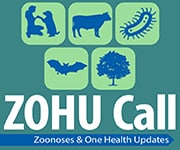April 2019 ZOHU Call
Topics:
- Chicken Liver–Associated Human Campylobacteriosis and Salmonellosis—Learning from Outbreaks to Develop Prevention Strategies
- Q Fever in Colorado – Collaborative One Health Response
- Multistate Outbreak of Human Salmonella Infections Linked to Pet Hedgehogs
Date: Wednesday, April 3, 2019
Continuing Education availability has expired for this webinar.
Schedule and Speakers:
One Health News from CDC
Casey Barton Behravesh, MS, DVM, DrPH, DACVPM
Captain, U.S. Public Health Service
Director, One Health Office
Centers for Disease Control and Prevention
dlx9@cdc.gov
Chicken Liver–Associated Human Campylobacteriosis and Salmonellosis—Learning from Outbreaks to Develop Prevention Strategies
CDR William A. Lanier, DVM, MPH, DACVPM
Senior Epidemiologist
USPHS; assigned to USDA, Food Safety and Inspection Service
william.lanier@usda.gov
Q Fever in Colorado – Collaborative One Health Response
Maggie Baldwin, DVM
Animal Incident Management Specialist
Animal Health Division
Colorado Department of Agriculture
Maggie.baldwin@state.co.us
AND
Jennifer House, DVM, MPH, DACVPM
State Public Health Veterinarian
Colorado Department of Public Health and Environment
Jennifer.house@state.co.us
Multistate Outbreak of Human Salmonella Infections Linked to Pet Hedgehogs
Connor Hoff, MPH
Assessment Epidemiologist, ORISE Fellow
Outbreak Response and Prevention Branch
Centers for Disease Control and Prevention
ook3@cdc.gov
Chicken Liver–Associated Human Campylobacteriosis and Salmonellosis—Learning from Outbreaks to Develop Prevention Strategies
- Chicken Liver—Resources for Illness Prevention (one-stop shop for chicken liver resources)external icon
- Outbreak Review Publication (Chicken Liver–Associated Outbreaks of Campylobacteriosis and Salmonellosis, United States, 2000–2016: Identifying Opportunities for Prevention)external icon
- Infographic for Chefs, Cooks, and Caterers: Cook Chicken Liver Like It’s Chicken (It Is)
- Intervention guidance for FSIS-regulated establishments, retail outlets, and foodservice entities: Minimizing the Risk of Campylobacter and Salmonella Illnesses Associated with Chicken Liver pdf icon[PDF – 9 pages]external icon
Q Fever in Colorado – Collaborative One Health Response
- National Association of State Public Health Veterinarians and National Assembly of State Animal Health Officials. Prevention and Control of Coxiella burnetii Infection among Humans and Animals: Guidance for a Coordinated Public Health and Animal Health Response, 2013 pdf icon[PDF – 30 pages]external icon
- Compendium of Measures to Prevent Disease Associated with Animals in Public Settings, 2017 pdf icon[PDF – 25 pages]external icon
- Evaluation of Factors that Would Initiate or Propagate Epidemic of Coxiellosis in the U.S. Domesticated Goat Population pdf icon[PDF – 104 pages]external icon
- Epizootiological investigation of a Q fever outbreak and implications for future control strategiesexternal icon
- Q Fever in Pregnant Goats: Pathogenesis and Excretion of Coxiella burnetiiexternal icon
- Q Fever fact sheet pdf icon[PDF – 12 pages]external icon
Multistate Outbreak of Human Salmonella Infections Linked to Pet Hedgehogs

